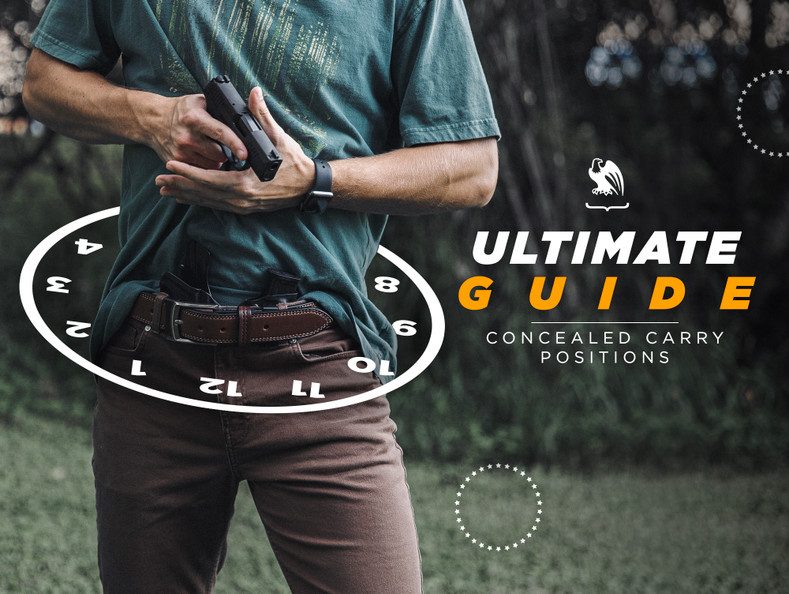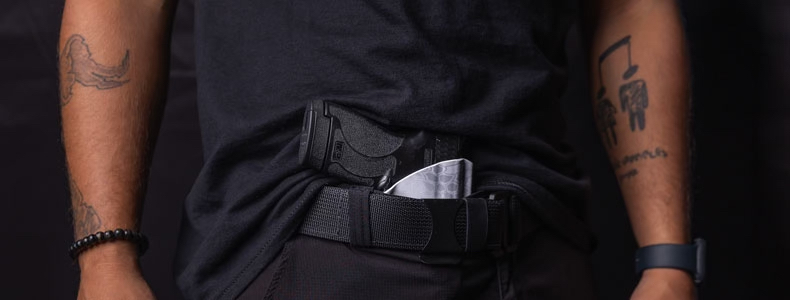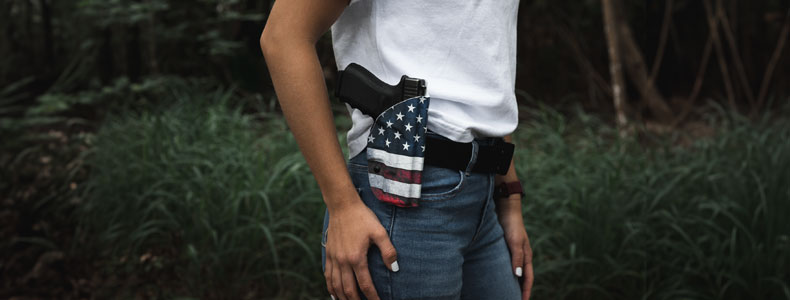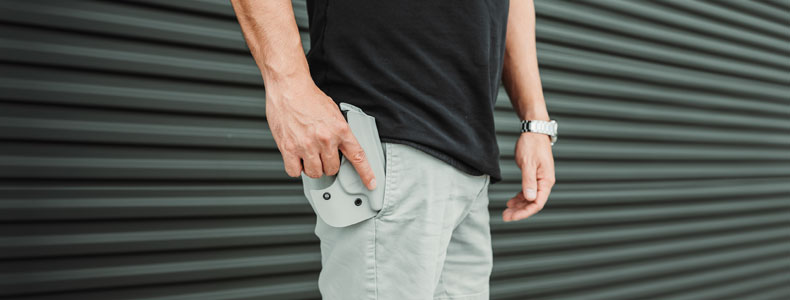Concealed Carry Positions: Ultimate Guide

Whether you’re new to concealed carry or you’re thinking about mixing things up, you’re probably interested in your options when it comes to positions to carry in.
There are no hard and fast rules when it comes to carry positions. The best concealed carry positions for you come down to your personal preference, body type, clothing style, lifestyle, and what is the most comfortable and concealable for you.
Carry positions can be easily broken down into two categories: inside the waistband and outside the waistband. From there, we like to refer to the different positions as hours on a clock. Since the human body is round (at least sort of), this makes it easy to visualize where you’re carrying your gun. Just imagine standing on the face of a clock with your belly button facing 12 o’clock, your back facing 6 o’clock, and so on.
Let’s dive into our all-encompassing guide to the different concealed carry positions.
Products Mentioned In This Article
Inside the Waistband
We’ll start with the most common carry method, which is inside the waistband (IWB) carry.
This method is pretty self-explanatory – in this position, your gun and holster are placed inside the waistband of your pants between your clothing and your skin.
There are a variety of ways to carry IWB. Depending on your body type, clothing, and daily activities, you will likely find that some IWB positions are more comfortable and concealable for you than others. For example, a position that works well for a carpenter who stands all day might not be the best choice for a mortgage loan officer who sits a lot.
We’ll go over the different IWB carry positions next, so you can get a better idea of which ones might be most compatible with you and your lifestyle.
12 o’clock
We’ll start with the 12 o’clock position, which is located right beneath your belly button.
This position is good for people who want to carry a longer gun. If you sit a lot throughout the day, you might find this position comfortable since it’s less likely to dig into your body while you are sitting down.
Carrying in the 12 o’clock position also allows you to easily draw your pistol as it’s sitting right at the front of your body.

Appendix (1-2 o’clock)
Appendix carry, often referred to as AIWB, is one of the most common IWB carry positions. Carrying appendix means that if you are right-handed, your gun is sitting at a 1-2 o’clock position, or 10-11 o’clock if you are left-handed.
With AIWB, your gun is easily accessible at the front of your body, allowing you to quickly draw whenever needed. While this position is comfortable and concealable for most people, keep in mind that it could actually be more difficult to conceal for certain body types.
When you are sitting down, there is potential for your holster to dig into your thigh or groin when carrying AIWB. This can be a safety hazard since it means that your pistol could be pointing directly at your body.
If you want to learn more about AIWB carry, check out our complete guide here.
Kidney Carry (4-5 o’clock)
Another popular IWB carry position is 4-5 o’clock (or 7-8 o’clock for lefties), also known as kidney carry.
While this position is generally considered one of the most comfortable, it can also be a bit awkward to draw from since it sits right behind your hip. Larger pistols are typically not suited for this position because of this.
One way to make it easier to draw from this position is to adjust the cant of your holster. Tilting your gun’s grip toward your hip can make it easier to access.
Small of Back (5-6 o’clock)
Carrying small-of-back in a 5-6 o’clock or 6-7 o’clock position for lefties can be comfortable and easy to conceal. Still, it’s not recommended by most professionals due to its potential safety hazards.
With your gun sitting right at the small of your back, you are at risk of serious spinal injury in the event you fall or are pushed into something. Not only that, but if you are lying on your back, it also prevents you from being able to draw your weapon.
Even drawing from this position can be a safety hazard. Small of back is one of the most difficult CCW positions to draw from since you have to reach all the way behind you to access it. Because of how awkward it is to draw, you are at a greater risk of muzzling yourself or someone else in the process.
For more information about small of the back carry, check out our article here.

Cross Draw (10-11 o’clock)
As the name implies, this position involves crossing your arm over your body to draw your weapon. With cross draw, your holster is seated between your weak side hip and navel at the 10-11 o’clock position, or 1-3 o’clock for lefties.
While not commonly used anymore, this position does allow for easy concealment and easy access when drawing. Just be mindful of the muzzle as you draw so you don’t flag yourself or anyone else.
An adjustable holster is key when carrying in this position so you can adjust the negative cant so the grip is pointed toward your belly button.
Outside the Waistband

Since an IWB holster is worn inside the waistband of your clothes, you can probably guess what the OWB – or outside the waistband – position is. Many people find OWB carry incredibly comfortable because of the layers between the gun and your skin.
While carrying outside the waistband offers more flexibility regarding the size of gun you can carry comfortably, you may have to get a little creative about concealing it. In order to conceal carry in OWB carry positions, you may have to wear additional layers like a jacket.
But what positions can you carry outside the waistband? Almost any of them! When it comes to concealed carrying, there aren’t any rules saying you have to carry in one spot on your waist versus another. The key to a good carry position is ensuring that it’s comfortable and you can easily draw your weapon.
However, you’ll likely find that a few positions are somewhat difficult to conceal OWB. For example, most people elect not to carry appendix or 12 o’clock since it is nearly impossible to conceal outside the waistband in these positions.
For more in-depth information about OWB carry, check out our “How to Wear an OWB Holster for Concealed Carry“ article.
And now, here is everything you need to know about outside the waistband concealed carry positions.
Strong-Side Carry (3 o’clock)
Located at 3 o’clock if you are right-handed, or 9 o’clock if you are left-handed, strong-side carry is most commonly worn outside the waistband. Most law enforcement officers carry strong-side since it’s so quick and easy to access.
If you plan to conceal carry, this position might not be the best option for you since it is positioned right on your hip, making it difficult to hide under most clothing. Additionally, if you plan to carry for long periods, you might find this position uncomfortable as it positions your gun right on your hip bone.
Kidney Carry (4-5 o’clock)
This position may be popular for IWB, but it’s also a common position to carry OWB.
Kidney carry is located at 4-5 o’clock if you are right-handed or 7-8 o’clock for lefties. Since your firearm sits right behind your hip in this position, it is generally pretty easy to conceal.
Keep in mind that if you have a larger gun, you may find this position harder to draw from. Of course, carrying a smaller pistol or adjusting the forward cant of your holster can remedy this.

Small of Back (5-6 o’clock)
While you might not believe it, small-of-back carry can be worn OWB just as easily as it can IWB. Carrying in a 5-6 o’clock, or 6-7 o’clock for lefties, can be comfortable and easy to conceal. Keep in mind, however, that due to the safety hazards associated with this position, it’s not typically recommended.
A few main concerns are associated with small-of-back carry. First, if you are pushed onto your back or fall down, you risk injury to your spine, which could be fatal. Additionally, being able to draw your weapon if you are lying on your back is nearly impossible from this position, rendering you defenseless.
Many people elect not to carry in this position because it is one of the most difficult concealed carry positions to draw from. As you are drawing, you risk muzzling yourself or someone else. It’s also quite uncomfortable to reach both hands behind you, one for drawing and the other for clearing your clothing. For more information about small of back carry, check out our article here.
Cross Draw (10-11 o’clock)
Similar to carrying on your strong side, while carrying in a cross-draw position is easy to access, it can prove difficult to conceal. Cross draw means your holster and gun are positioned on your weak side between your hip and navel at 10-11 o’clock – or 1-3 o’clock if you are left-handed.
Since the gun is placed on the opposite side of your body, you will have to cross your arm over your body to draw. As a result, carrying in this position requires additional practice to ensure you don’t muzzle yourself or someone else while you are drawing.
One thing that can help make drawing your gun easier is having an adjustable holster. Adjusting the negative cant of your holster so the grip is pointed toward your belly button can make it more accessible.
Pocket Carry
On the waistband carry isn’t for everyone. Some people prefer pocket carry, which requires a pocket holster. Pocket holsters keep the gun secure in your pocket by using friction and pressure while still allowing you to easily draw.
Typically pistols with smaller frames work best for pocket carry because you can conceal them more easily than a larger firearm.
Interested in learning more about pocket holsters? Check out our “Why You Should Carry A Pocket Holster” article to learn more about the safety of pocket carry, what guns to carry, and other things to consider.

Other Concealed Carry Options
Worried you won’t find an on-body concealed carry position that works for you? There are a number of off-body carry options and alternative on-body positions that may work for you. Keep in mind there are pros and cons to these positions. Some of these other options for concealed carry are:
- Ankle holsters
- Belly bands
- Carrying off-body in a backpack or purse
- Shoulder holster
It’s important to consider all the factors of alternative and off-body carry positions. Make sure it works for your lifestyle, no matter what method you choose.
If you want more information about the pros and cons of off-body carry, check out our article here.
Choosing the Right Clothes for Concealed Carry
No matter what position you choose to carry in, having the right clothes can play a big part in concealability and printing. In general, tight clothing is not ideal as it will lead to more printing. The looser the clothing, the more concealment you’ll have.
Darker colors also make concealed carry easier. Since darker fabrics don’t show shadows as much as their lighter counterparts, they can mask printing better. Patterns like checkers, floral prints, camo, and plaid also help hide printing.
When it comes to pants, ensuring you have belt loops is typically best, especially if you plan on using a gun belt (which we recommend). If your pants are tight fitting in the waist, you may need to go up in size to accommodate for a holster if you decide to carry IWB.
While wearing a jacket is not required to conceal carry, it may help you conceal your weapon better because of the extra layer of fabric. Keep in mind that is one more article of clothing you will have to move out of the way to access your gun if needed, however.
Ultimately, what clothes work best for you can depend on a variety of factors, including body type, carry position, and, of course, weather. We suggest giving yourself a quick check in the mirror before leaving the house to make sure you aren’t printing, especially if you are wearing a new shirt that you haven’t carried with before.
Which Carry Position Is Best for Me?

The right carry position for you depends on your body type, your lifestyle, and what you find most comfortable. To learn more about which positions are most compatible with your body type, check out our “Best Concealed Carry Positions for Different Body Types” article.
If you are torn between IWB and OWB, check out our “OWB vs. IWB: Which is Best for Concealed Carry?” article.
But those aren’t the only factors to consider. When choosing a holster and carry method, there are a few questions you should ask yourself:
- Can you safely and quickly draw from the position without risking injury to yourself or anyone near you?
- Is your gun concealable?
- Is the position comfortable based on your activity level (i.e. sitting or standing)?
- If you got into a combat scenario, could you defend your gun?
If you can’t decide what will work best for you, try a few positions out. Put on your gun and holster and try sitting, standing, and walking around. Make sure whatever position you choose is going to work for you and your needs.
As a responsible gun owner, regular training should always be a part of your routine. That being said, make sure you practice dry fire training by drawing your unloaded pistol from its holster. If you find yourself in a situation where you need to draw your weapon, you don’t want to be fumbling around trying to get it out of the holster.
Ready to take the next step toward buying a belt or holster for your gun? We recommend visiting our Holsters by Gun Model page. For all our belt and holster options and for more information to help you choose the carry system that works best for you, visit our Vedder Holsters website.
Looking for items beyond holsters and belts? Check out our Resources Page for popular product links like lights, lasers, first aid, maintenance, and more.
To stay up-to-date on all of the latest Vedder Holsters content and offerings, follow us on Facebook, Instagram, and Twitter. And be sure to check out our sister company, GeoGrit, for durable, RFID-blocking minimalist wallets proudly made in the USA.



